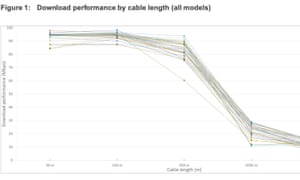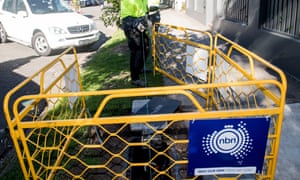Copper wiring and fibre-to-the-node are not the only issues, some modems are just not up to the job, a new study has found
Poor NBN speeds are often blamed on the government’s decision to
scale back the fibre-to-the-premises roll out and switch to the cheaper
fibre-to-the-node, but a study commissioned by the Australian Communications and Media Authority (Acma) proves part of the problem can lie closer to home.
Acma commissioned testing lab Enex to test run 43 modems on the market or sold by internet service providers when people sign up for the NBN on a fibre-to-the-node or fibre-to-the-building service. This means that at least for part of the connection, the legacy copper line is used in addition to the new fibre.
Enex tested the modems using six NBN lines sold offering 100 megabits-per-second (Mbps) download speeds and 40Mbps upload speeds. The highest consumer offering is fibre-to-the node or fibre-to-the-building/basement (FTTN/B).
In December 2018 and January 2019, big brands including D-Link, Linksys, Netcomm, Netgear and Billion were tested for performance on the NBN via cable connection, then on wifi, between 5 metres and 50 metres away from the device, as well as through walls or other obstacles that can interfere with wifi performance.
Enex found that wifi networks in surrounding apartments and houses
with their own wifi networks can interfere with speeds on the devices,
but interference causes more problems in the 2.4GHz band.Acma commissioned testing lab Enex to test run 43 modems on the market or sold by internet service providers when people sign up for the NBN on a fibre-to-the-node or fibre-to-the-building service. This means that at least for part of the connection, the legacy copper line is used in addition to the new fibre.
Enex tested the modems using six NBN lines sold offering 100 megabits-per-second (Mbps) download speeds and 40Mbps upload speeds. The highest consumer offering is fibre-to-the node or fibre-to-the-building/basement (FTTN/B).
In December 2018 and January 2019, big brands including D-Link, Linksys, Netcomm, Netgear and Billion were tested for performance on the NBN via cable connection, then on wifi, between 5 metres and 50 metres away from the device, as well as through walls or other obstacles that can interfere with wifi performance.
A total of 44% of the devices operating in the 5GHz range were able to provide decent speeds at 50 metres away, whereas a majority in the 2.4GHz band performed poorly at 50 metres and some ceased to offer a wifi connection entirely.
How much you pay for the modem sometimes has no impact on the quality of the connection, Enex found. In some cases, cheaper devices outperformed more expensive devices, even those from the same manufacturer.

Acma chair Nerida O’Loughlin said that when connected via cable to the NBN connection many of the devices performed similarly, but the results varied wildly when switched to wifi. She said this is something consumers should be informed about.
“Telcos and modem suppliers need to provide good advice to consumers about the features and performance of individual modems, especially wifi performance,” she said.
“Consumers should also ask their telco about the performance they can expect from the modem supplied to deliver their service.”
But the modems can’t solely shoulder the blame for poor connections. Those tested dropped in speed significantly once the length of the copper used in the connection exceeded 450 metres. However, NBN Co typically doesn’t use copper lines in excess of 1km.

No comments:
Post a Comment